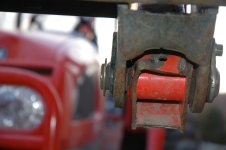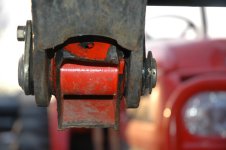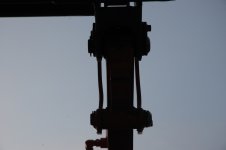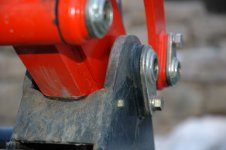Coyote machine
Super Member
- Joined
- May 4, 2009
- Messages
- 7,641
- Location
- Southern VT
- Tractor
- 22 SANY SY 50U, '10 Kioti DK 40se/hst KL-401 FEL, loaded tires, KB-2485 bhoe, Tuffline TB160 BB, Woods QA forks, MIE Hydraulic bhoe thumb & ripper tooth, Igland 4001 winch, & GR-20 Log Grapple. Woods BBX72" Brush Mower. Diamondplate aluminum canopy
Finally I have some pics to add to this thread. Check them out. I will add an explanation of each one after making sure they display correctly.
First pic is the left fel arm in the raised and curled position, viewed from in front of the tractor.
Second pic is the other side, same position and view.
Note in both pics the black item/plate is the QA plate pushed in on both pics at the bottom of the plate, and the end of the fel arm (orange rectangular tubing) just below it; with the end of the fel tubing all mangled up on both sides.
Next pic is with the bucket overhead shooting the 1/2 moon brackets from underneath, against the sky as background. This shows the twisting of the 1/2 moon plates on the left side of the fel arm.
Last pic is the right side fel arm from underneath with the bucket in the full dump position. It shows the black Q A plate, seem in the previous pics, with the plate pushed up against the stop, (on the underside of the fel arm) that is supposed to stop this kind of damage from occurring in the first place.
I am confident of the above statement because my friend brought over his used DK-55 and it has a brand new loader he bought with the tractor and its KL-401 pistons are NOT able to extend enough to allow them to touch the fel arm and the stop on the underside does NOT allow any further travel once it makes contact with the Q A plate. Additionally, the total design and its geometry and attachment method further prevents the type of damage going on on my tractor, since it has an additional support bar above the fel arm that restricts excessive travel. Thus problem solved on that model loader- but NOT on my KL-351.
I've got many more pics, but I think this represents what is going on, and the damage done.
Comments, ideas, suggestions.....
First pic is the left fel arm in the raised and curled position, viewed from in front of the tractor.
Second pic is the other side, same position and view.
Note in both pics the black item/plate is the QA plate pushed in on both pics at the bottom of the plate, and the end of the fel arm (orange rectangular tubing) just below it; with the end of the fel tubing all mangled up on both sides.
Next pic is with the bucket overhead shooting the 1/2 moon brackets from underneath, against the sky as background. This shows the twisting of the 1/2 moon plates on the left side of the fel arm.
Last pic is the right side fel arm from underneath with the bucket in the full dump position. It shows the black Q A plate, seem in the previous pics, with the plate pushed up against the stop, (on the underside of the fel arm) that is supposed to stop this kind of damage from occurring in the first place.
I am confident of the above statement because my friend brought over his used DK-55 and it has a brand new loader he bought with the tractor and its KL-401 pistons are NOT able to extend enough to allow them to touch the fel arm and the stop on the underside does NOT allow any further travel once it makes contact with the Q A plate. Additionally, the total design and its geometry and attachment method further prevents the type of damage going on on my tractor, since it has an additional support bar above the fel arm that restricts excessive travel. Thus problem solved on that model loader- but NOT on my KL-351.
I've got many more pics, but I think this represents what is going on, and the damage done.
Comments, ideas, suggestions.....
Attachments
Last edited:




